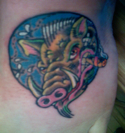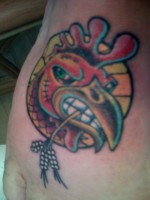 Tattoos have become very popular of late. Tattoo Facts & Statistics notes that “thirty-six percent of those ages 18 to 25, and 40 percent of those ages 26 to 40, have at least one tattoo, according to a fall 2006 survey by the Pew Research Center.” As popular as tattoos are with twenty and thirty somethings, sailors have been marking their bodies for most of history.
Tattoos have become very popular of late. Tattoo Facts & Statistics notes that “thirty-six percent of those ages 18 to 25, and 40 percent of those ages 26 to 40, have at least one tattoo, according to a fall 2006 survey by the Pew Research Center.” As popular as tattoos are with twenty and thirty somethings, sailors have been marking their bodies for most of history.
 Many years ago a retired ship’s captain told me that his youth deckhands often had “HOLD FAST” tattooed across the knuckles of their hands so they wouldn’t fall when they went aloft. They also often had a pig tattooed on one foot and chicken the other which was supposed to protect you from drowning. He told me that he never figured out which foot was supposed to be tattooed with the chicken and which with the pig. He would say, with a twinkle in his eye, that he never got the tattoos because he was afraid of getting them on the wrong feet.
Many years ago a retired ship’s captain told me that his youth deckhands often had “HOLD FAST” tattooed across the knuckles of their hands so they wouldn’t fall when they went aloft. They also often had a pig tattooed on one foot and chicken the other which was supposed to protect you from drowning. He told me that he never figured out which foot was supposed to be tattooed with the chicken and which with the pig. He would say, with a twinkle in his eye, that he never got the tattoos because he was afraid of getting them on the wrong feet.
 There are two versions of the story as to why a pig and chicken will prevent a sailor from drowning. The first is just that pigs and chickens do not like water, so they would like to be out of the water as soon as possible. A slightly more plausible explanation is that pigs and chickens were often carried on deck in wooden pens. In a shipwreck the pens would often wash ashore with the other debris from the ship. Pigs and chickens were at times th only survivors of ship wrecks. A more prosaic explanation was that having a pig and chicken tattoo would guarantee that a sailor eats well as he carries his hams and eggs with him at all times.
There are two versions of the story as to why a pig and chicken will prevent a sailor from drowning. The first is just that pigs and chickens do not like water, so they would like to be out of the water as soon as possible. A slightly more plausible explanation is that pigs and chickens were often carried on deck in wooden pens. In a shipwreck the pens would often wash ashore with the other debris from the ship. Pigs and chickens were at times th only survivors of ship wrecks. A more prosaic explanation was that having a pig and chicken tattoo would guarantee that a sailor eats well as he carries his hams and eggs with him at all times.
One variation was to have a tattoo of a pig on the left knee and a rooster (cock) on the right foot signified “Pig on the knee, safety at sea. A cock on the right, never lose a fight.”
Sailors also got bird tattoos to signify the completion of voyages. Sparrow, swallow and/or blue bird tattoos were used to signify 5,000 miles sailed. Compass roses, stars, ships, dragons, turtles, rope, daggers and cannon all have their own significance to the wearer of the tattoo. To read more click here or here.
Ironically, while tattooing has been practiced for thousands of years, the word “tattoo” entered the language relatively recently. Captain Cook first recorded his derivation of the Samoan word “tatau” in his log in 1769. Tattooing was obviously very popular among seaman of the day. Many of the Bounty mutineers of 1789 were identified by their tattoos. Fletcher Christian, the leader of the mutiny, was reported to have “a star tattooed on his left breast,” and to be “tattooed on his backside”.
So far I have resisted the urge to follow Christian’s example and have my backside tattooed but a star or two sounds interesting.

Hey, those are my feet! B^)
Thx for the link. I also have the ‘hold fast’ tattoos, though that pic isn’t my hands.
Those are your feet. Kewl!
This post on tattoos is the single most popular post on the blog. Your feet are famous!
thats awesome i have a cock on my foot and my wife has a pig on hers and i also have the hold fast haha
The way I heard it when I was in the Navy, the pig and chicken were tattooed to prevent drowning, as neither the pig nor chicken could swim. If God looked down upon your wrecked ship, and saw a pig and chicken, He would take pity and take them into His hand (and thus rescue the sailor as well)
there are 2 actual meaning behind them. The first one is that in the old days they use to house the animals (mainly the pig and chicken) in wooden crates. When a ship went down the wooden crates would float thus taking the animals to shore safely. The second one is those 2 animals are notorious for not liking water so it is supposed to help your feet from sinking.
The chickens and pigs were held in wood crates like you said but the wood was hollowed out to keep weight down. By default they would automatically float.
my papa told me tht a pig and a cow on ur feet were to keep ur feet gronded n the blue brids around ur ankles were to keep ur head above water.
Hmmm. In the ‘Hold fast’ photo, the letters are printed upside-down from the climber’s viewpoint . . .legible only to anyone FACING him! Not a great safety tactic, methinks. . . .
My Dad ex RCN Naval Air had swallows on his chest and a pig on his knee. He always used to say “pig on the knee safety at sea”. I miss him.
Can you get the rooster and pig tat if your not a sailor?
Why not?
Why, if your not a sailor?
*you’re
Of course you can.
Jj, You can get any tattoo you like. Just don’t drink around any Boatswains Mates. Boats don’t take kindly to those who haven’t worked deck. 🙂 Actually, there was a BM I served with who literally had all the same tattoos I did, just in different places (hold fast on my left arm/leg, his were on the right. Bottle of rum on my left leg, his on his right arm. My anchor on the right leg, his on his left, etc.). So the tattoos are fairly common in the navy. I am still active, so this is only a few months ago that I saw this man.
Looking for a tattoo that would represent souls lost at sea. Have been a merchant mariner for 30 years and want a new tattoo to honor the Mariners lost when the El Faro went down.
An old salt I served with on the Newport News (circa 1964) had a hanging roster tatoo on the outside of his right calf. He said it signified he’d sailed the Cape of Good Hope in a storm. I believe him. He was a most impressive man.
Hello Shipmates,
I’m retires USN. Back in 1964 (I was17) I was serving on the USS Newport News (CA-148) where I met BMC Roland Seaman (No shit, that was his name) the most tattooed man I’m have ever met. He had a hanged roosters tattooed on the outside of his left calf. When I ask him about it, he said he’d sailed around the Cape of Good Hope. I haven’t see one since and I have never been able to verify it. I believer him then and now. But I like to know the origin…. Can you help?
Thanks
Ed
Chief it also means that he can tell the ladies that his cock hangs below his knee.